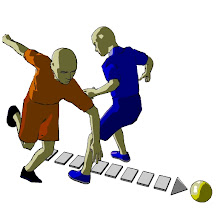Everything must be right. To this day Brazil puts out the most professional soccer players in the world. Soccer players are their second leading export behind sugar. But there is something interesting that many of the players have in common: 50% of all professional players in Brazil come from the "golden triangle," an area beginning in Sao Paolo and extending 75 miles north and west. Why do so many of Brazil's players come from this area? Everyone in Brazil loves the game. Street and campinho games are everywhere. What is it about this area that produces so many players? In the 1960's the coaches of the national team ever brought a Uruguay training technique to improve the play of Rivelino, Tosatao, Carlos Alberto and Pele and others. That game was Futebol de Salao. As the team found success and their training was scrutinized. The players loved it. At the 1970 world cup the National team had a "futsal" court built on top of their Hotel in Mexico.
The civic leaders of Sao Paulo were sold. If the pros liked the game the kids would play it. They built courts in the city. The initiative was quickly proliferated into the suburbs and cities as they were expanding north and west. Futebol de Salao became the game you had to play. Clubs sprang up. Kids played it in droves. This area converted to Futebol de Salao before and with more commitment then other areas in Brazil. This was their advantage. What might seem like a small advantage early is the difference in becoming a pro and club player. In Brazil if you want to be pro you had better play lots of Futebol de Salao. Now kids growing up in this area know someone who is pro, they see the pathway, they dive in and participate.
Players don't develop on their own, they are products of their environment. That environment handles our most precious commodity: our youth. Everything must be put into creating a fertile, nurturing community that supports the love of the game and the joy of play.
It's so much more than simple combinations of games and coaches and skills. It is contstant humility and learning. the devil is realy in the details of building the fragile
What does this mean? For players it means to redefine success as player growth and create a culture of skillful creative kids who love the game, are hungry for more and a pathway they can see. For coaches its education and enlightenment of a better model, and for parents it becomes the establishing of sound principles: that the child comes first, that soccer is creative, and the best soccer is played closest to home.
TK



